Dark Beer Vs Light Beer: What's The Actual Difference Between The 2?
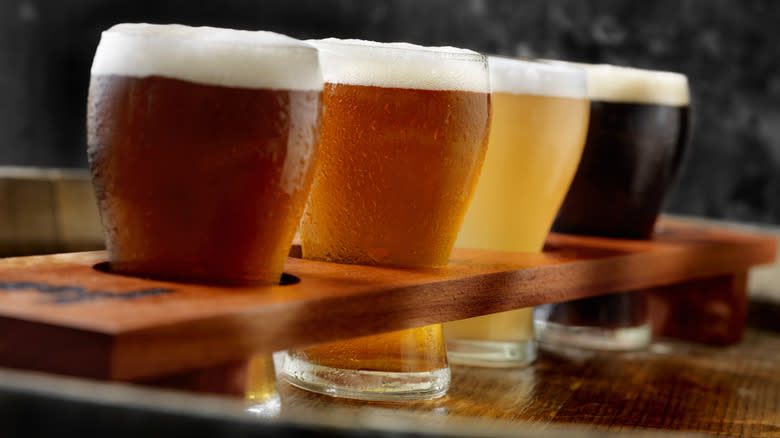
Anyone who thinks wine is the most confusing type of alcohol has probably never tried to break down the differences between types of beer. Perhaps because wine is seen as the fancier drink, it has long held onto its reputation for producing hundreds of confusing names and styles, while most people only know a few popular styles of beer. In reality though, the world of beer also contains hundreds of varieties, many of which have more obvious differences to the average drinker than a merlot and pinot noir, even as they look similar and carry newly invented labels like "Hazy IPA" that don't really help you understand what they're going to taste like. And one of the more misunderstood distinctions is between light and dark beer.
Light and dark beers seem easily distinguishable on the surface, as if they are the white and red wines of the beer world. But the color differences obscure lots of ways in which the two styles can overlap in taste, texture, and production. The distinction isn't entirely superficial as dark beers do tend to have a more robust flavor, but beyond that much more comes down to the specific style of light or dark beer than the color itself. Those differences stem from many decisions made during the brewing process, including what ingredients to add and how brewers handle them. It all culminates in a stunning diversity of outcomes that makes dark versus light a mere starting point on a beer lover's journey.
Read more: The 27 Best Bourbon Brands, Ranked
What Is Light Beer?
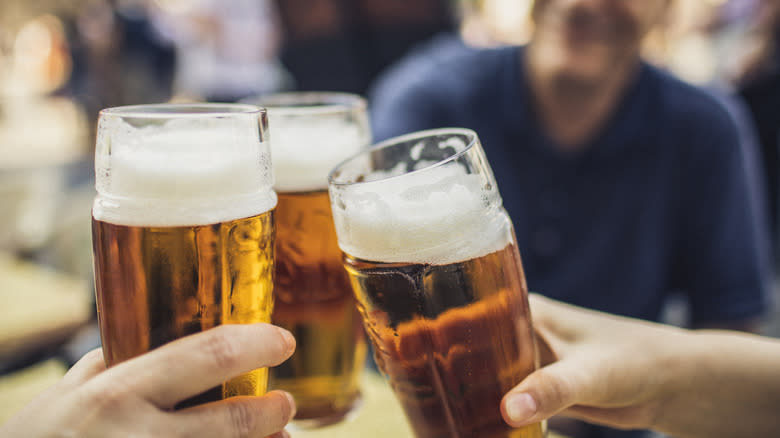
When talking light versus dark beer, we're talking about the hue of the drink, not low calorie options like Bud Light. In this context, the distinction refers to beers that are golden in color, including the majority of the most popular beers in the country, like pilsners and IPAs. When most people think of beer, they are picturing a light beer.
All beer is made with four basic ingredients: water, yeast, malt, and hops. Regarding the color of beer, malt is the key ingredient. Malt refers to any grain used to brew beer, yet the standard is malted barley. Other grains used include wheat, rice, oats, or corn, although they are usually paired with some barley instead of being used on their own. Any one of these malts can produce light beer; what matters is how they are prepared before being added to the fermenting mixture.
Malts are the primary flavoring ingredient along with hops. While hops provide bitterness, measured on the IBU scale, malts provide sugar, which balances out the taste and provides fuel for the yeast to create alcohol. However, in their natural state most malts are relatively bland, so they are toasted to bring out more complex notes for flavoring the beer. This is where the distinction between light and dark comes into play. Other added ingredients along with the fermentation process can affect color, and malts that are roasted longer to bring out more flavor also produce darker color beer.
What Is Dark Beer?
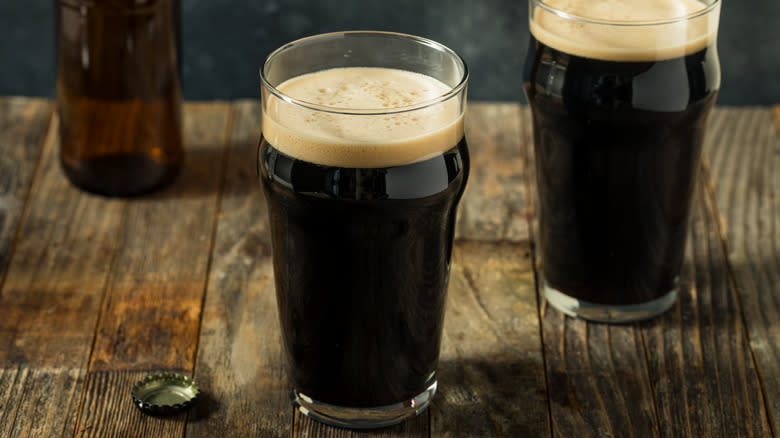
Dark beer is any beer that is darker in color, which usually comes from the toasting of the barley and other malts. The common styles of dark beer that most people recognize would be porters and stouts, with Guinness being the most popular example served in American bars. Dark beers cover a range of styles and not all have that same black coloring. Amber and red beers like a German bock or Vienna lager would also be considered dark beers. Dark beers can also get color from the ingredients brewers use for taste and complexity, like chocolate and coffee.
While the longer, darker roasting process of the malts is the primary distinction that produces the color of dark beer, those dark-roasted malts make up only a small percentage of each recipe. Most beers have a mixture of lightly toasted base malts, which are there to help fermentation, and specialty malts which are roasted to give beer a caramel flavor. Specialty malts usually only make up no more than 15% of the mixture, and dark malts are usually less than 5%, even in dark beer. A small change in the composition of those malts can produce a big change in the color of the final product. This is the biggest misconception about dark beer. Because it takes so little to change the color, it's not always heavy, and it can come in a wide range of flavors and textures.
Light And Dark Beers Are Both Produced As Ales And Lagers With Lots Of Regional Styles
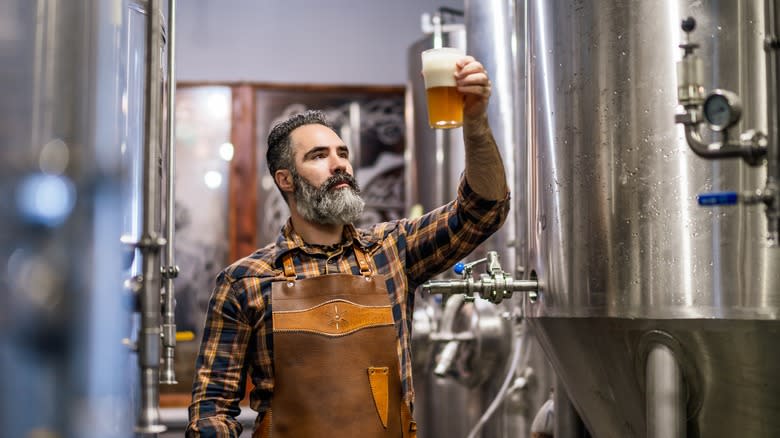
Both light and dark beers comprise broad categories that encompass a range of styles. The two big fermentation categories representing most beers are lagers and ales, and either brewing method can produce a dark or light beer. Ales and lagers differ in the type of yeast used to make them, with ales requiring "top fermented" yeast which gathers in a layer of foam on the surface of brewing beer while lagers use "bottom fermenting." From there you get more specific styles with familiar names like brown ales and wheat beers.
Because there is so much diversity in both light and dark beers, you'll find examples of ales and lagers in both categories. Examples of light lagers include pilsners and Mexican lagers like Dos Equis. Darker lagers include German dunkels and doppelbocks. Well-known dark beers like stouts and porters on the other hand are ales, and so are many light beers like sour ales, hefeweizens, and all the different styles of IPAs.
Light and dark beers are also produced across many regions, although lighter beers tend to be more popular in warmer climates. Most dark beers like bocks and stouts are associated with Northern European countries like the U.K. and Germany. Lighter beers are more universally produced, whether its warm-weather beers like Thailand's Singha and Mexico's Corona, or colder-weather offerings like the Netherland's Heineken and Czech pilsners.
Light Beers Tend To Taste Crisp And Refreshing
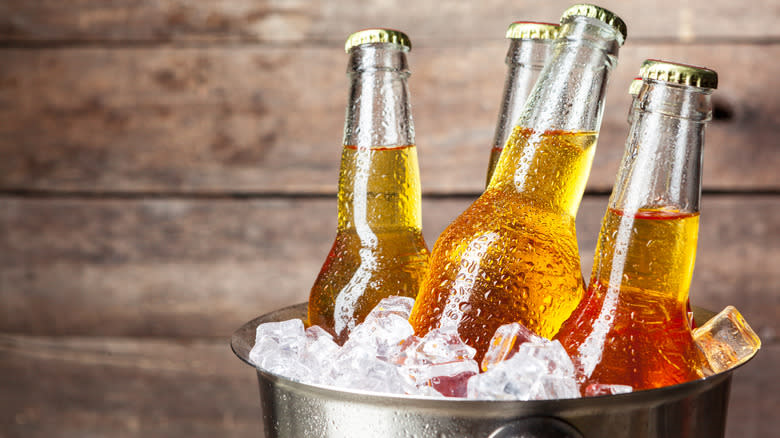
There are lots of characteristics that are independent of the color of your beer, but one area where there is often the most noticeable difference is taste. Both light and dark styles can produced lots of different flavors, but the longer roasting of the malts in dark beers tends to make the tasting notes stronger and more pronounced. Light beers have a milder, brighter taste that makes them easier to drink and great beers for summer. They are refreshing, with notes that fall on the fruity end of the spectrum, but that doesn't mean they can't be complex. IPAs are not just bitter, and can taste of citrus and fruit. Wheat beers are creamier, and often contain notes of banana or light spices like clove. Pilsners are drier, with a stronger emphasis on clean hop flavor that can be grassy and mildly bitter.
Since they contain malts that are cooked longer, dark beers are naturally associated with a strong roasted flavor. Common tasting notes that get tossed out for dark beer are chocolate, coffee, and a browned sweetness reminiscent of caramel or toffee. Dark beers have lots of natural complexity, and depending on the style you may get vanilla, licorice, and lots of nutty flavor profiles as well. Finally you have drier styles like dark brown lagers and Irish stouts, which have a lighter more balanced flavor that mixes mild roasted malt notes with more hoppy notes than other dark beers.
Dark Beers Cover A Wider Range Of Colors
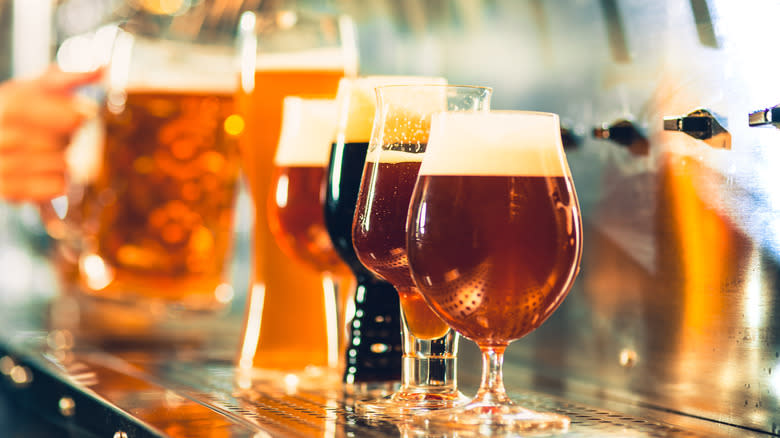
Because dark and light beers are primarily distinguished by color, you might think there's a clear cutoff dictating where one becomes the other, but like a lot of beer definitions, it's more of a personal judgment call. For dark beers there are the dark brown and black varieties that clearly fall into the category, yet amber, light brown, and red colored beers can also be included as dark beers. Examples include the Marzen Oktoberfest beers that are usually a copper color on the lighter end. That said, they are malty and complex in flavor, so they tend to be thought of as dark beers. Amber lagers also bridge the gap, with Vienna lagers closer to dark beers and American ambers generally lighter in color with a more crisp, sessionable appeal.
Light beers cover a narrower range, with the vast majority being some kind of yellow, although this can vary from a thin straw color like Budweiser to the deeper golden hue of an aged Belgian saisons. Like dark beer, there are some light beers that are hard to classify. Popular sour beers like gose are usually light and more golden, but some veer into bright orange or red colors that can be quite saturated. These middle ground situations exist, where both color and flavor defy classification, and you just need to go with your personal preference.
Both Light And Dark Beers Have Wide Variations In Alcohol Content
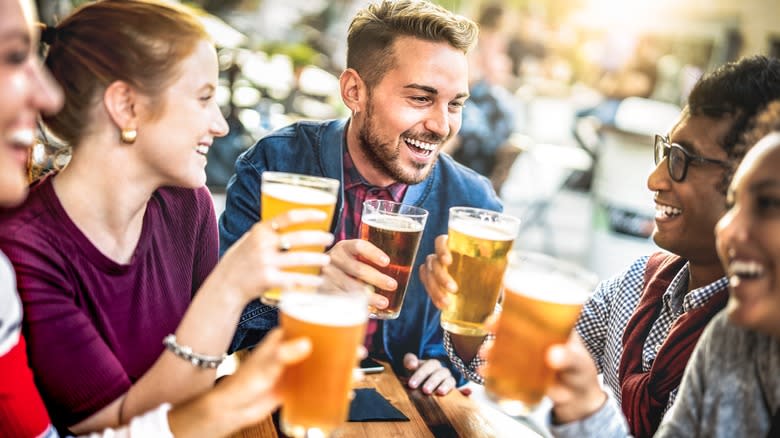
Another misconception regarding light versus dark beer is how much alcohol each contains. Dark beers are usually thought of as having a higher alcohol-by-volume (ABV) content, but this is mostly a myth. It is true that some styles of dark beer, like an imperial stout, have ABVs above 9% or 10%, but other stouts, porters, and black lagers have alcohol levels as low as 4%, which is less than many light beers. It all depends on the style, not the color. Irish stouts, British porters, and American brown ales all usually fall under 5% ABV. Doppelbocks, Baltic porters, and some others will range from 7% up to 14%. The only good way to judge ABV is to check the beer's label or ask your bartender.
There are quite a few light beer styles that are high in alcohol too. IPAs, especially craft varieties, are often around 7% ABV and can hit as high as 10%. Belgian tripels and strong ales, usually golden in color, ranging from 8% to as high as 12% ABV. It's mostly the popular mass-produced styles like American pilsners and wheat beers that have the low ABV range of 4% to 5%.
Light And Dark Beer Have Similar Calorie Counts
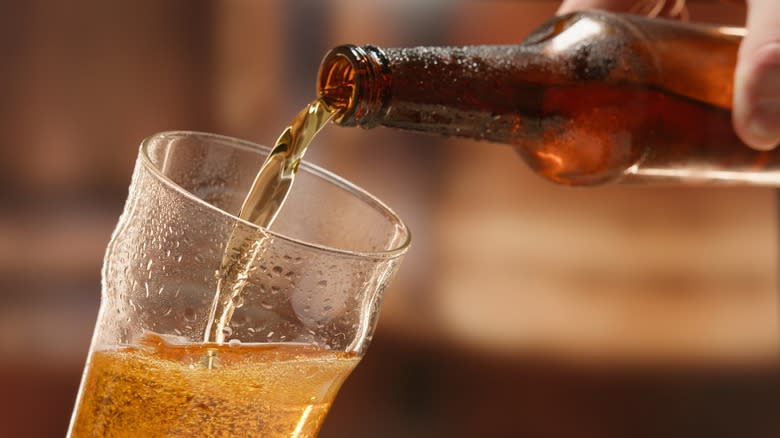
No beer is exactly good for you, but just like with ABV, dark beer carries a reputation of being heavier and higher in calories than lighter beers. Yet this isn't really true. There are low-carb beers out there, and it is the case that some darker styles like stouts will have slightly more calories on average, but just like with flavors and alcohol content, calories vary greatly by brand. And some darker beers like brown ales have average calorie counts just as low as lighter beers.
Common light beers like Corona, Budweiser, and Heineken are relatively low in calories, landing in an average range of 130 to 150 for a can. This is actually higher than some popular dark beers. Your standard Guinness only has 126 calories in the same amount of beer, and Newcastle's Brown Ale has 138.
On the higher end you'll find stouts and porters from popular brands like Bell's that top 200 calories, but many lighter beers rise to that range too, especially more bitter iterations like IPAs. Lagunitas Little Sumpin' Sumpin', a popular wheat IPA, has 230 calories per bottle, and a Stone IPA has 210. To see just how small the difference is you can even look within the same brands. Sierra Nevada makes a porter that has 183 calories per can, while its iconic pale ale is nearly identical at 175.
Dark Beers Pair Well With Strong And Spicy Food
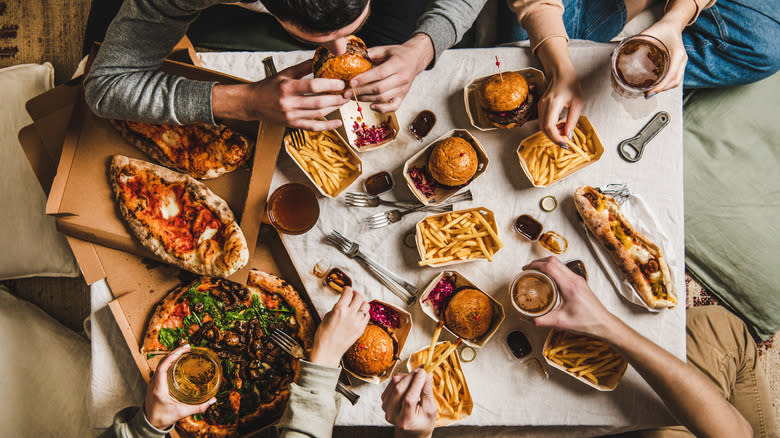
While a nice, crisp beer will go great with most meals, there are some foods that dark beers will and won't work for. The stronger flavor of dark beer can overwhelm lighter meals instead of complementing them, so it's not the best choice for salads, light vegetarian meals, and fresh seafood. If you're serving something hearty, though — or you want the best beer style for a winter meal — dark is the way to go, as it pairs wonderfully with barbecue, stews, or braised dishes and roasts. Medium dark beers like ambers and brown ales are also perfect for spicy food, where their sweeter malt notes cut against the heat, but their slightly less robust taste won't cover up the spicy flavors. Particularly underrated is pairing them with desserts, as dark beer's chocolate notes are natural matches for a lot of after-dinner treats.
On the lighter end, a hoppy light beer also makes a nice choice with spicy foods, and a pilsner is ideal for bright cuisines that make use of heat like Mexican or Thai. Roast chicken and most pasta dishes have a richness that works well against lighter beers, and it's also the best beer to pair with pizza. The same goes for fried foods where it helps to have something clean and effervescent to counter the heavy meal. You really can't go wrong with a classic light beer, so you don't have to play by too many rules here.
Read the original article on Tasting Table.

